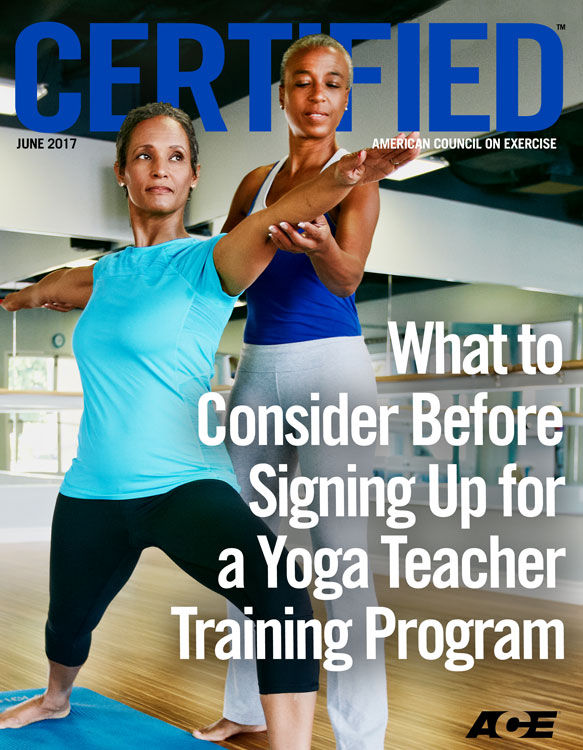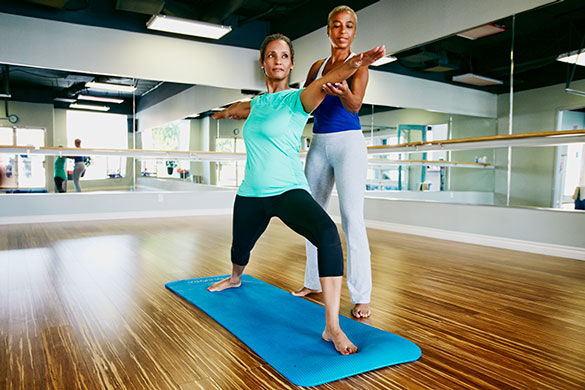
If you’re seriously considering becoming a yoga instructor, you’re not alone. Although it’s been popular in the U.S. for several decades, yoga has experienced unprecedented growth over the past few years, with more than 36 million people reporting that they participate in this ancient practice. As a result, yoga teacher training programs have also grown exponentially, creating an opportunity for health and fitness professionals who want to expand their offerings by becoming a yoga instructor, but also raising concerns about the quality of the programs available.
If you’ve made it your goal to become a yoga instructor, this explosion of available training programs can make it difficult to know how to choose the highest quality program that best suits your needs and interests. Before you sign up and commit yourself to 200 or more hours of instruction, read on to learn about what you should consider prior to choosing a program. From knowing your “why” to investigating your options, this article takes you through the step-by-step process to discovering the best program for you.
The Art and Science of Living
The practice of yoga is far more than the assortment of physical movements performed on the mat. In the words of Indra Devi, the first female student of Tirumalai Krishnmacharya, who is credited with bringing yoga to the west in 1947, “Yoga is the art and science of living.” This powerful statement is a testament to the profound teachings of this transformative practice, one which has touched the lives of countless people around the world for thousands of years.
Although yoga isn’t entirely new to the U.S., it has experienced unprecedented growth over the past few years. According to the findings of the 2016 Yoga in America Study jointly conducted by Yoga Journal and Yoga Alliance, the number of individuals practicing yoga in this country increased to 36.7 million in 2016, up from 20.4 million just four years earlier. In addition, of the 2,000 yoga students surveyed as part of this study, 74% reported having practiced yoga for fewer than five years. So, what has led to this booming growth in recent times?
“Teach what is inside you. Not as it applied to you, to yourself, but as it applies to the other.” — Tirumalai Krishnamacharya
While many people are drawn to the benefits that the physical practice of poses provides, such as increased strength and improved flexibility and balance, the multidimensional aspects of yoga, as outlined in the eightfold path described in the Yoga Sutras of Patanjali, offer profound emotional, mental and spiritual benefits as well. As such, many people are drawn to practice for a wide variety of personal reasons, ranging from decreasing stress to deepening one’s own spiritual development.

Yet, there is another aspect contributing to yoga’s seismic growth and increasing popularity that warrants examination: The rapid rise in the number of yoga teachers in the U.S in recent years. Given the plethora of positive benefits and enlightening aspects of the practice, it’s easy to understand why many individuals are compelled to become teachers in order to share the gift of yoga with others. However, it’s the rate at which individuals are becoming teachers that is astonishing: The Yoga in America study reports that, to date, for every one active teacher there are two people in training to become a yoga teacher.
These numbers, which potentially signal an oversaturation of yoga teacher training (YTT) programs, has spurred concern among some long-time yoga teachers, including Stacy McCarthy, whose yoga journey spans nearly three decades and includes studying under Sri K. Pattabhi Jois, the founder of Ashtanga Vinyasa yoga.
“I am concerned that the training of new yoga teachers is outpacing the number of yoga students, as more than 14,700 teachers registered with Yoga Alliance just last year alone,” notes McCarthy, who serves as a professor of yoga studies at MiraCosta College in San Diego, Calif. “Some of the major changes I’ve seen in yoga in recent years include YTT programs being offered as a central component of many yoga studios business models, as well as the development of branded YTT programs by corporate entities.”
It is this shift in direction that is not sitting well with senior teachers like Maty Ezraty, who feels that it has become a matter of quantity over quality when it comes to training new yoga teachers.
“Unfortunately most yoga 'schools' are not schools; they are businesses,” says Ezraty, who co-founded YogaWorks in 1987. “You often have people with charisma that can fill a YTT program, you have students that may not be truly ready for such a training, and you have this 200-hour 'stamp' that people mistakenly believe alone will make them a yoga teacher. It’s fair to say we’re having a bit of an industry crisis.”
Before embarking down the path toward any profession, it’s important to have an understanding of the current landscape of a given field, and yoga is certainly no exception to this rule. The acknowledgment of the present state of affairs is not intended to dissuade individuals who are passionate about becoming yoga teachers from doing so. Rather, it’s simply to offer you the opportunity to thoughtfully examine what is presently transpiring so that you can navigate your own personal journey with greater clarity, awareness and purposeful intention.
Exploring Your “Why”
Making the conscious decision to pursue the path of becoming a yoga teacher is not to be taken lightly. As such, it’s imperative that you start your journey with an honest reflection on your own personal intentions and motivations.
“It’s important to take the time to clearly define for yourself what it means to be a yoga teacher and why you want to become one,” says McCarthy. “In an interview of more than 1,000 yoga teachers in the U.S. and Canada, the top three reasons people gave for becoming a yoga teacher included loving the practice, wanting to share the benefits of yoga with others and wanting a change in lifestyle.”
“The success of yoga does not lie in the ability to perform postures, but in how it positively changes the way we live our life and our relationships.” — T.K.V. Desikachar
While there is certainly continual personal growth and evolution as a yoga teacher, the change in lifestyle that many people seek as a byproduct of teaching yoga is one that Ezraty believes should be explored and adopted beforehand as a student.
“I think you have to live the lifestyle of the yogi before you teach yoga,” says Ezraty. “This is tricky because different people have different opinions of exactly what that means, but it involves doing a fair bit of your own personal work through yoga and other kinds of spiritual means. You really have to clean out your own closet before you consider teaching, as being a yoga teacher requires one to be emotionally strong.”
While the exact approaches to living the yogic lifestyle may be subject to debate, ranging from a certain way of eating to a certain way of living, the embodiment of the ethical guiding principles known as the yamas and niyamas should ultimately serve as the foundation from which to explore the other limbs of yoga, as outlined by Patanjali.
Assessing Your Personal Practice
The regular practice of asana, pranayama and meditation, as described in the eightfold path, are also integral aspects of living a yogic lifestyle, yet examining the depth and consistency of one’s personal practice is often overlooked when considering starting a YTT program.
“While the experience of the teacher leading a program is an important factor, so too is the experience level of the student entering into a YTT program,” says Ezraty. “We are seeing many students coming into 200-hour training who do not yet know the basics, as they have not been practicing long enough. In a way, it’s like trying to teach college-level math to someone who is not yet ready for college-level material—even the best teachers cannot be expected to do that.”
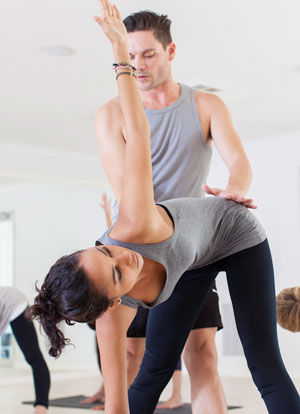
Ezraty advocates that individuals considering becoming a yoga teacher have a strong personal practice that they do primarily on their own.
“Putting your mat down and practicing on your own takes a certain level of maturity, and your mind has to be focused enough to do that,” says Ezraty. The infamous quote from Pattabhi Jois, “Do your practice and all is coming,” speaks to this point, as it is through tapas—one’s own fiery discipline, drive and commitment to the practice of yoga physically, mentally and spiritually—that the true transformation of body, mind and spirit can occur.
McCarthy acknowledges that for some students the idea of starting and maintaining a self-guided practice can be challenging, just as it was for her in her early years as a student.
“At first it was a challenge to intently focus on each moment of the practice on my mat, and it was only possible to do so when I was in a class setting led by an instructor,” recalls McCarthy. “But as I became more and more committed to my own development, I realized that I was the one guiding my own practice the whole time. This awakening still gives me the will to get on my mat daily and develop my home practice to the best of my ability.”
From McCarthy’s perspective, the hardest part of developing a home practice is often just rolling out your mat, but the process of getting started need not be complex or overly complicated. “Begin by just standing on your mat and setting an intention,” offers McCarthy. “Whatever comes from there is the beginning of a home practice. Simply allow your heart to guide you.”
In addition to establishing and maintaining a consistent personal practice for at least several years, Ezraty recommends that prospective teachers attend a minimum of one or two workshops a year with senior teachers from all different backgrounds, ideally with a good amount of Iyengar yoga included because of the depth and integrity of training Iyengar teachers receive. “If you’ve done all of that and still want to be a yoga teacher, then you should start looking for a good training,” says Ezraty.
Investigating Your Options
As you begin the process of evaluating the various YTT programs out there, it’s important to keep your own personal objectives front of mind. As McCarthy explains, there are many different intents to programs, ranging from vocational trainings and spiritual explorations, to those that are similar to retreat-style vacations.
“Based on what someone is seeking to gain from the training, prospective students should review the curriculum, the expertise of the faculty and the cost of the program,” advises McCarthy. “The challenge in the marketplace for those who are seeking a career as a yoga teacher is that there is a lack of consistency regarding what it means to be a graduate of a YTT program.”
One of the commonly offered pieces of advice for prospective yoga teachers is to choose a YTT program that is recognized by Yoga Alliance. This is because most employers, whether at yoga studios or gyms, require that individuals be either a registered yoga teacher (RYT) or an experienced yoga teacher (E-RYT) at the 200- or 500-hour level.
While important from an employment standpoint, finding a Yoga Alliance-recognized YTT program is only one element of consideration when making your choice—and it is not without debate within the yoga community. Many longtime teachers would like to see less emphasis placed on Yoga Alliance designations as the primary criteria for teaching yoga, and more focus directed toward establishing and enforcing more rigorous training programs that follow consistent standards when it comes to denoting the desired qualifications for individuals to start teaching yoga.
“The problem is that the public thinks, or wants to think, that [Yoga Alliance registration] is good enough,” notes Ezraty. “The reality is that Yoga Alliance does not certify you as a yoga teacher, they register you, which merely acknowledges that you have completed some type of coursework. In my opinion, the 200 hours itself doesn’t really mean anything, as it all depends on what happens during the course of those hours, and beyond.”
Ezraty believes that a good YTT program should be led by a trainer who is going to help you as a unique individual become the teacher that you need to be, something that takes skill and experience.
“You don’t want to go to a training where you’re going to turn out to be like everyone else in the room,” notes Ezraty. “You want a professor-type teacher who has been around a long time, and who has the information and tools you need, and which you can choose how to blend together to become your own teacher.”
If possible, Ezraty recommends that individuals seek a training that includes an apprenticeship as part of the program, in which you work directly under the guidance of an experienced teacher assisting classes and teaching portions of classes, allowing for valuable discussion and feedback that will drastically improve your ability to teach. “As a yoga teacher you need to be able to examine bodies— to see them and to know what to do with them,” says Ezraty. “It’s an interaction with physical human beings, each of whom is unique on a number of different levels.”
Your Intentions for the Future
After completing a YTT program, it’s important to assess your personal ambitions and intentions for the future as they relate to teaching. McCarthy advises newly trained teachers to do a bit of soul searching, and to examine if teaching yoga is in fact their true passion and calling using the following guiding questions to assist their exploration:
- Is teaching yoga really what I love to do? If so, am I good at it too?
- What are my core strengths?
- What is my plan to make enough money to sustain and thrive in my lifestyle?
Although it’s not always discussed, being a yoga teacher is not an easy profession, especially not full-time. That’s why Ezraty discourages newly trained teachers from jumping right in to full-time teaching.
“This is not a profession that I would recommend someone who just took a 200-hour course go into full-time and give up what they currently do,” says Ezraty. “Teaching yoga full-time is a very difficult profession and it is not suited for everyone.” This may explain, in part, why The Yoga in America study found that of the 1,700 yoga teachers surveyed, 67% work fewer than 10 hours per week as a yoga teacher, and only 29% of yoga teachers cited yoga as their primary source of income.
“It’s important to realize that teaching yoga for a living isn’t as straightforward as completing a YTT program,” notes McCarthy. “Many teachers, upon graduating from a YTT program and starting a yoga career, find it hard to make ends meets, let alone to make the kind of money they want. They also often find that other aspects of their life get put on the back burner, including no longer keeping up with their personal practice.”
This reality is echoed in the The Yoga in America study, with only 39% of the teachers surveyed reporting they practiced yoga five or more times per week. Both Ezraty and McCarthy agree that maintaining a personal practice on most, if not all, days per week is extremely important, both for your own well-being and personal growth, and for the quality of your teaching.
“If you are sacrificing your personal practice to teach yoga, whether part-time or full-time, you really need to stop and think, because in the long-term it will not work,” shares Ezraty. “In order for your teaching to last 20 to 30 years, you need to have your own personal practice.”
Ezraty also stresses the importance of ongoing education as a part of your professional path as a yoga teacher. After all, in the words of B.K.S. Iyengar, “Learning is as much an art as teaching.”
At the end of the day, the study and practice of yoga really needs to be at the core of who you are as a yoga teacher, no matter how many classes you teach per week.
“Teaching yoga is not a ‘leave it at the office’ job,” says McCarthy. “You have to live your yoga and love it. If not, and it is taught merely as an exotic, Eastern calisthenics class, then you are barely tapping the surface of yoga’s real intent.”
Further Your Knowledge

If you’re inspired to create and offer more compelling, thoughtfully structured yoga classes, watch as Jessica Matthews discusses how to utilize a science-supported blueprint for fostering more inclusive class experiences. You will learn how to apply human movement principles to asana selection and instruction; how to develop appropriate progressions and regressions of poses; and how to design intelligently structured and sequenced classes.
A Science-based Blueprint for Designing Yoga Classes [Recorded Webinar]
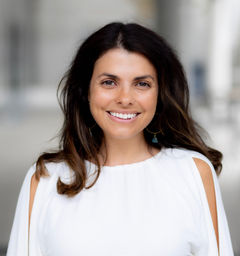




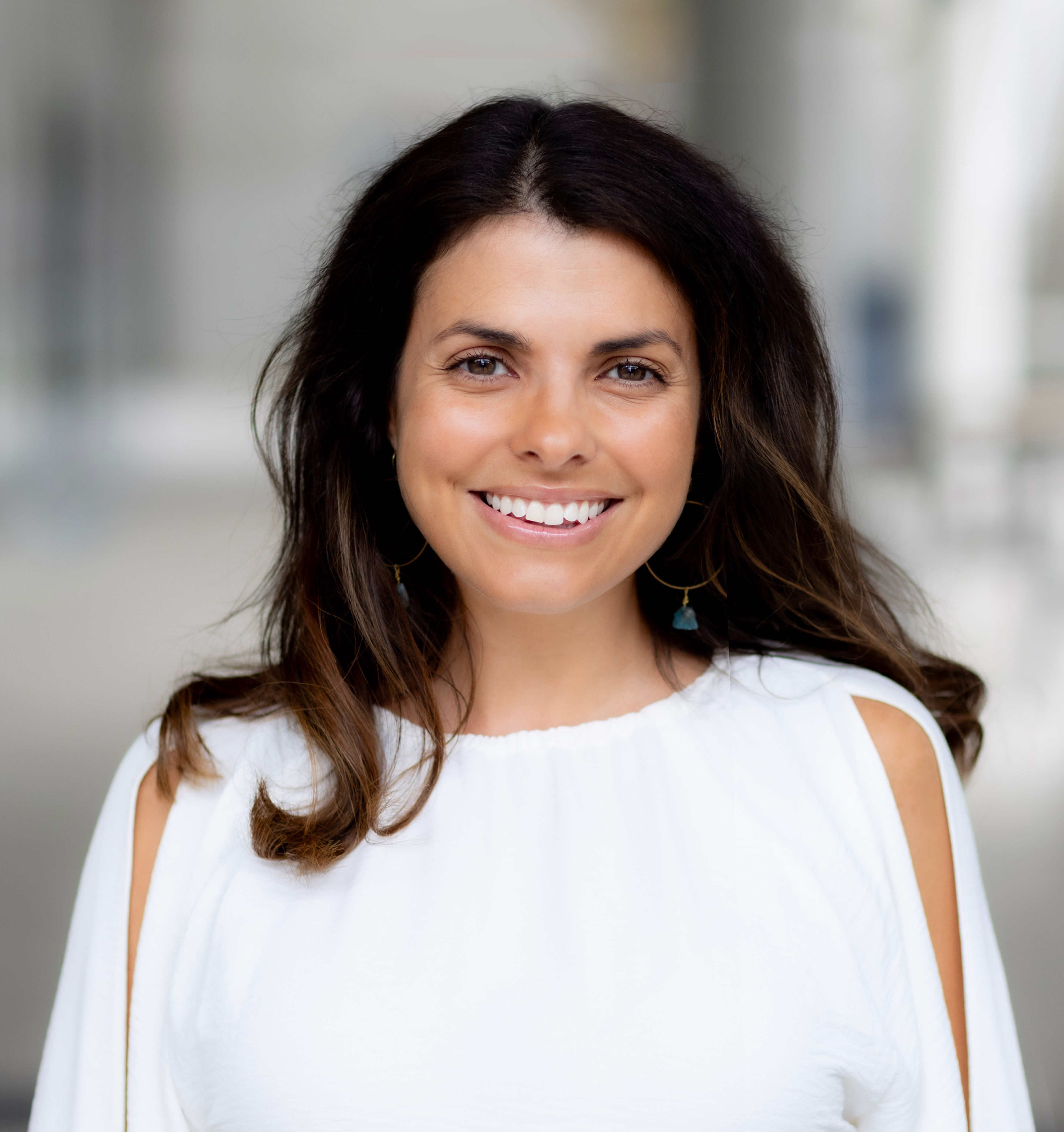 by
by 